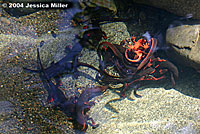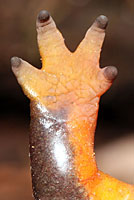Salamander Behavior and Life History -
Reproduction, Eggs, and Young


| Reproduction and Young | |||||
| Aquatic Amplexus and Egg Laying | |||||
 |
 |
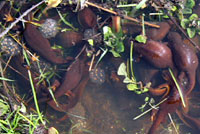 |
|||
| A big ball of California Newts forms in the breeding pond when a male and female in amplexus are approached by several male newts who want to take the female. | Male and female California Newts in amplexus in the breeding pond. The males hold on tight and swim around the pond using their huge tails. One uses the toes on his hind feet to stroke a female, probably to make her receptive to take his spermatophore. | Views of a large mass of female California Newts in the breeding pond, as they go about laying and securing their eggs. | |||
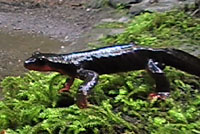 |
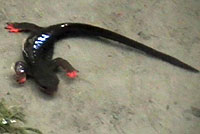 |
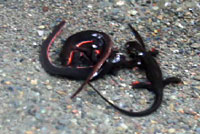 |
|||
| A video of Red-bellied Newts at their breeding creek in the redwood forest in Mendocino County. | In this video, Male Red-bellied Newts walking around a creek at the beginning of the breeding season, waiting for females to arrive. | This video shows two male Red-bellied Newts trying to steal a female away from a male in amplexus with her, but they do not succeed. | |||
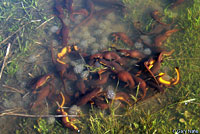 |
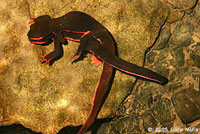 |
||||
| A congregation of breeding adult California Newts under water with many egg sacs. | A mass of breeding Red-bellied Newts. © Jessica Miller - Livingunderworld.org |
Red-bellied Newts in amplexus underwater |
|||
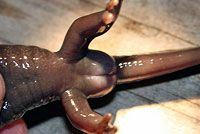 |
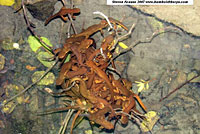 |
||||
| Adult male Northwestern Salamander found in a pond with many eggs during the breeding season. Here you can see the swollen vent typical of breeding males. | A mating ball of Rough-skinned Newts © Steven Krause |
During the breeding season, adult male Rough-skinned Newts develop nuptial pads on the toes to improve their ability to hold onto females during amplexus. Compare with the toes of a breeding female without these pads. | |||
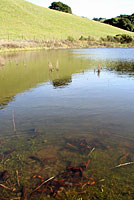 |
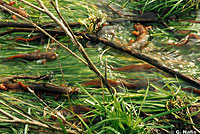 |
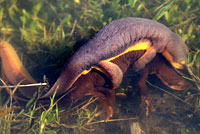 |
|||
| California Newts and egg sacs in shallow water at the edge of a pond. |
Part of a group of hundreds of adult male California Newts that were observed during their journey to a breeding pond as they slowly crawled up the shallow outflow from the overflowing pond. Their bodies had already undergone the change to live an aquatic existence, with smooth skin and flattened tails for swimming. | California Newts in amplexus. | |||
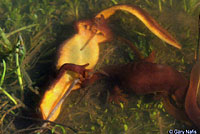 |
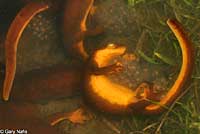 |
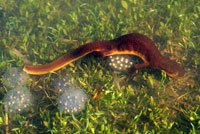 |
|||
| Female California Newt grasping onto underwater vegetation preparing to lay eggs | Female California Newt with egg sacs. | Female California Newt laying her eggs underwater and attaching them to vegetation. | |||
 |
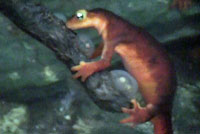 |
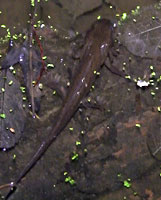 |
|||
| In this video, female California Newts repeatedly attack and bite at newt egg sacs. Maybe they want to destroy the eggsfor some reason, maybe they are trying to eat them, or maybe there is another explanation. | In this video a female Sierra Newt clings to several recently-laid egg masses in a shallow pool in Fresno County. | This short video shows a Northwestern Salamander breeding pond during the February breeding season, including several egg masses, and a paedomorph in the water at night. | |||
 |
 |
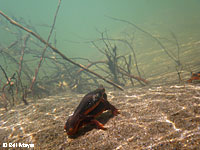 |
|||
| Adult Sierra Newts breeding underwater at a shallow edge of the Yuba River in Nevada County in March. Notice the egg sacks attached to sticks in the background. © Bill Mayer |
|||||
| Development of a California Newt Larva | |||||
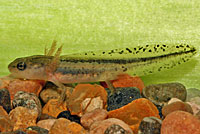 |
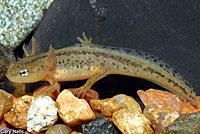 |
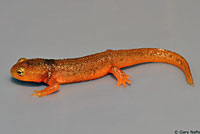 |
|||
| A recently-hatched aquatic Coast Range Newt larva on the left and the same Coast Range Newt larva a month later on the right. |
The same California Newt larva seen to the left a few weeks later in the process of metamorphosing into its terrestrial phase. (Note the reduced gills, orange coloring, and thinner tail. | ||||
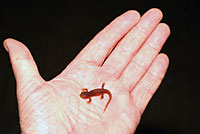 |
|||||
| This is the same juvenile California Newt see above right two weeks later, fully transformed into its terrestrial phase. | |||||
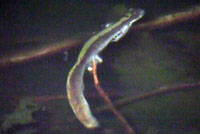 |
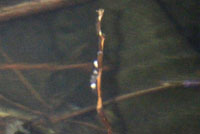 |
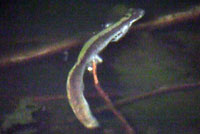 |
|||
| A female Western Long-toed Salamander laying eggs underwater at night in early February, King County, Washington. | Eggs on an underwater stick laid by the female Western Long-toed Salamander to the left, soon after she finished. | This short video shows two female Western Long-toed Salamanders underwater laying their eggs on submerged sticks at night.. After the first one is finished we see the eggs she left behind. (Same as in the pictures to the right.) | |||
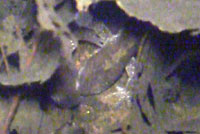 |
|||||
| Unlike the much more visible Pacific newts, who breed in full daylight, Western Long-toed Salamanders do their breeding and egg laying at night, and they seem to do it under the cover of leaves on the bottom of the pond. In this video we can see a couple interacting under some leaves in a breeding pond.. |
|||||
| Below is a series of pictures showing the development of the Northwestern Salamander from eggs to aquatic larva to air-breating juveniles. All pictures were taken underwater except for the last one of a metamorphosed juvenile. |
|||||
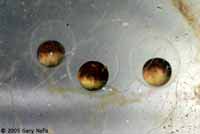 |
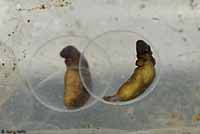 |
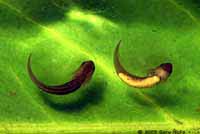 |
|||
| Recently-laid eggs inside an egg mass | Mature eggs | Eggs about to hatch | |||
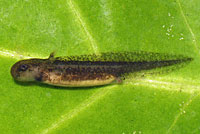 |
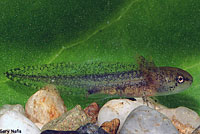 |
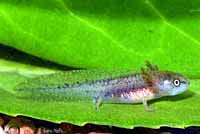 |
|||
| Larva right after hatching | Maturing larva | Larva with newly developed legs | |||
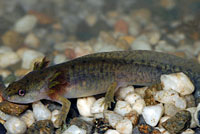 |
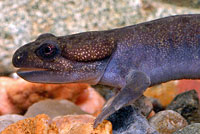 |
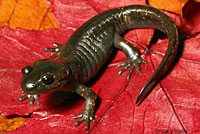 |
|||
| Mature larva | Larva with gills almost completely reduced This larva is already spending some of its time on land. |
Fully-metamorphosed juvenile on land. | |||
| Terrestrial Salamander Courtship | |||||
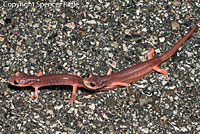 |
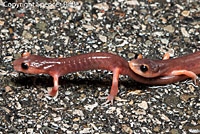 |
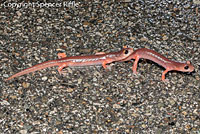 |
|||
| Adult pair of courting adult Monterey Ensatinas, Santa Barbara County © Spencer Riffle | |||||
 |
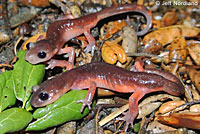 |
||||
| This pair of courting adult Monterey Ensatinas was found on a wet January night in San Diego County.© Jeff Nordland | This pair of courting adult Monterey Ensatinas was found on a wet January night in San Diego County. © Jeff Nordland |
||||
 |
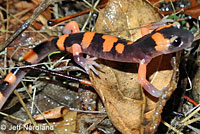 |
||||
| This pair of courting adult Large-blotched Ensatinas was found on a wet January night in San Diego County. © Jeff Nordland | This smaller male adult Large-blotched Ensatina was found only a few feet away from the pair shown to the left and was probably in competition for the female. © Jeff Nordland | ||||
 |
|||||
| Courting adult Oregon Ensatina intergrades, Marin County © Adam Gitmed | |||||
| Salamander Eggs | |||||
| Eggs of Salamanders that Breed and Lay Eggs in Water | |||||
c Salamander eggs that are laid in water have a layer of jelly around the ova. This jelly is to protect them from predators and from the elements since the eggs float exposed in water until they hatch. The young hatch into an aquatic larval form where they develop and grow in the water, breathing through gills, until they are ready to transform into their terrestrial form and breathe through lungs. Occasionally, they do not transform but remain in the water as gilled adults. |
|||||
| Western Newt Eggs | |||||
| Rough-skinned Newt |
|||||
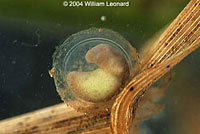 |
|||||
| From March to April at low elevations through summer at higher elevations, the female Rough-skinned Newt lays tiny eggs individually and attaches them to underwater vegetation or debris, then abandons them. © 2004 William Leonard | |||||
| California Newt | |||||
In winter and spring the female lays a spherical egg mass about one inch or less in diameter containing from 7 - 47 eggs and attaches them to submerged vegetation, branches, or rocks, then abandons them. Egg masses from many females often occur in clusters. |
|||||
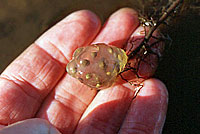 |
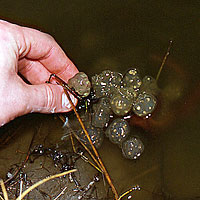 |
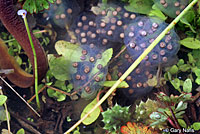 |
|||
| Single egg cluster attached to underwater vegetation |
Cluster of eggs attached to underwater vegetation |
Eggs at the shallow edge of a pond | |||
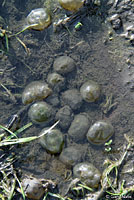 |
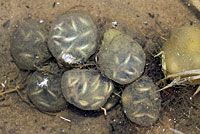 |
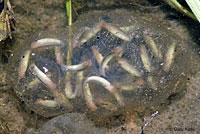 |
|||
| Eggs at edge of breeding pond | Mature Eggs | Egg with mature larvae |
|||
 |
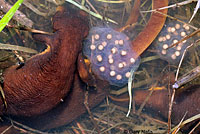 |
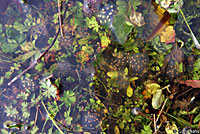 |
|||
| Female laying her egg mass underwater | Eggs at the shallow edge of a pond | ||||
 |
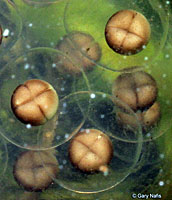 |
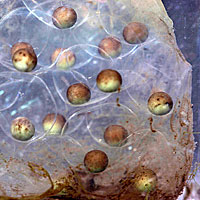 |
|||
| Eggs, close-up | Eggs, close-up | Eggs, close-up | |||
| Red-bellied Newt | |||||
From February to May, with a peak in March, the female Red-bellied Newt lays and attaches a flattened egg mass containing about 10 eggs under stones in the middle of a creek or under rocks overhanging the creek, or onto submerged roots, then abandons them. Many egg masses are sometimes found under one stone. |
|||||
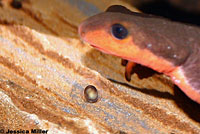 |
 |
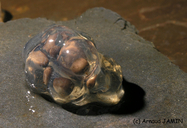 |
|||
| Adult Red-bellied Newt with a single egg. © Jessica Miller - Livingunderworld.org | Red-bellied Newt Eggs, Sonoma County. © 2008 Arnaud Jamin. From the CalPhotos collection. |
||||
| Sierra Newt | |||||
In early Spring the female Sierra Newt lays a spherical egg mass about one inch or less in diameter containing from 7 - 47 eggs to the sides and bottoms of stones and sticks in relatively fast-flowing water, then abandons them. Egg masses are attached just below the surface of the water. |
|||||
 |
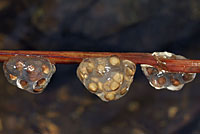 |
 |
|||
| Adult female underwater with several egg masses, Fresno County. | |||||
 |
 |
||||
| Newts with eggs attached to submerged branches in a creek, Fresno County. © Steven Britton |
Egg sacks attached to a rock in a creek, Butte County © Jackson Shedd | ||||
| Eggs of Ambystomatid Salamanders | |||||
| Northwestern Salamander | |||||
The female lays 30 - 270 eggs in masses that are roughly the size of a small grapefruit , and attaches them to underwater shrub branches, grass, or aquatic plants, then abandons them. Eggs are laid between January and April in low-elevation areas, June to August at higher elevations. |
|||||
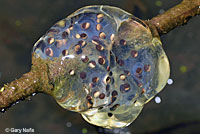 |
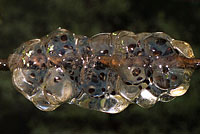 |
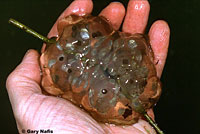 |
|||
 |
 |
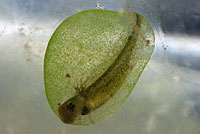 |
|||
| Close-up of freshly laid eggs | Close-up of developing embryos | Developing embryo, ready to hatch. The eggs often support the growth of algae inside the inner jelly layer. | |||
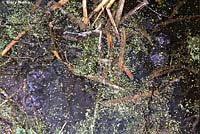 |
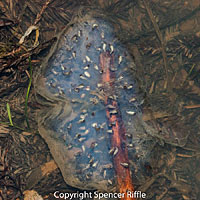 |
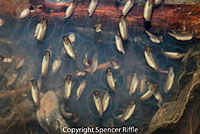 |
|||
| Several Northwestern Salamander egg masses in a pond. |
Egg mass, Humboldt County © Spencer Riffle | ||||
| California Tiger Salamander | |||||
| Eggs are laid individually, attached to stems or other objects underwater, then abandoned. Egg deposition occurs after the first heavy rains fill the breeding ponds, typically November - January. |
|||||
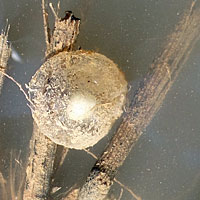 |
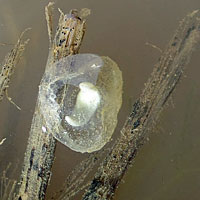 |
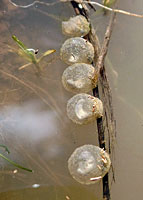 |
|||
| Egg in Contra Costa County breeding pond, © Mark Gary Left: egg on January18th Right: the same egg, January 23rd |
Maturing eggs in breeding pond, Contra Costa County © Mark Gary | ||||
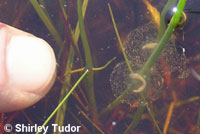 |
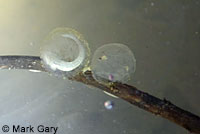 |
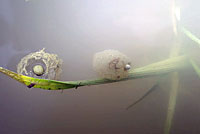 |
|||
| Eggs in water, Monterey County © Shirley Tudor |
Maturing eggs in breeding pond, February 6th, Contra Costa County. Embryos have developed gills, some have hatched. © Mark Gary |
Eggs in breeding pond Contra Costa County © Mark Gary | |||
| Western Long-toed Salamander | |||||
In Winter (later at higher elevations) Females lay from 90 - 400 eggs in small masses containing from 1 - 81 eggs in shallow water, attaching them singly or in loose clusters to the undersides of logs and branches, or leaving them unattached on the bottom, then abandons them. |
|||||
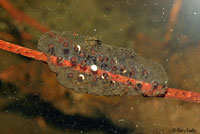 |
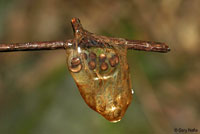 |
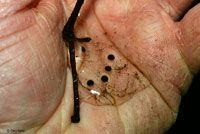 |
|||
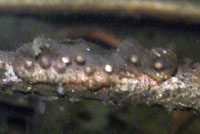 |
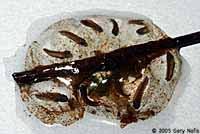 |
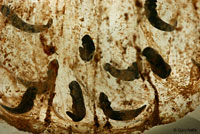 |
|||
| This short video shows some Western Long-toed Salamander eggs on submerged sticks. Some of the eggs are temporarily pulled out of the water for a better look. | Western Long-toed Salamander eggs with well-developed embryos close to hatching. |
||||
| Eggs of Salamanders that Breed and Lay Eggs on Land | |||||
| I have few pictures of the eggs of terrestrial salamanders. Often little is known about the breeding behavior of terrestrial salamander species. It is presumed that the females lay their eggs on land in cool moist places underneath rocks or logs or inside logs, where they are not easily discovered. Eggs are usually laid individually and are not surrounded with as much jelly as eggs that are laid in water. Most female salamanders remain with their eggs to protect them from predators. Young hatch from the eggs as miniature versions of adults, often when the rainy season begins in October and November. | |||||
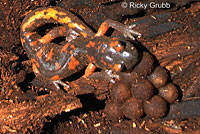 |
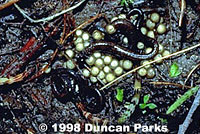 |
 |
|||
| On August 2nd, this adult Sierra Nevada Ensatina was discovered brooding approximately 10 eggs inside a rotting log of a fallen Giant Sequoia. © Ricky Grubb | These Gregarious Slender Salamanders were found underneath ground debris along with some eggs. As their name indicates. this species often forms communial nests, but the females typically leave the site after laying. Male and subadult salamanders will often still be found under the same cover as the eggs. © Duncan Parks | Old Arboreal Salamander egg cluster that was found attached to the underside of a log on the ground in Contra Costa County. A hatchling was seen just below the egg cluster. © Max Roberts | |||
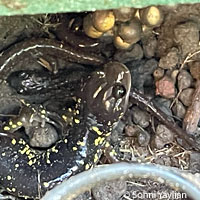 |
 |
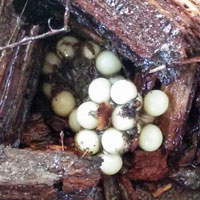 |
|||
| The adult Arboreal Salamander shown on the left (most likely a female) was found in an irrigation box in Sonoma County guarding a cluster of eggs attached to the box above her. The eggs were laid sometime at the beginning of July and they hatched in early October. The salamander stayed with them the entire time and continued there throughout the winter after they had hatched. The picture on the right shows the adult below a cluster of approximately ten hatchlings a day or two after hatching. They stayed in this cluster for several days. Afterwards the number of adult and juvenile salamanders observed in the box varies as they move in and out, with as many as ten observed at one time. © Sohni Yaylian | These eggs were found underneath some old redwood planks in a shaded area next to a house in Sonoma County. Though they were found near several aestivating Arboreal Salamanders in July when they lay their eggs, they are most likely the eggs of a slug or snail because of their opacity and because they don't appear to be attached to the wood. Gastropod eggs are sometimes confused for salamander eggs because of their similar size and because they are both laid in similar dark moist places. © Anonymous |
||||
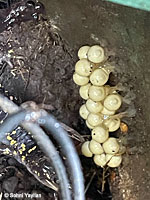 |
|||||
| Freshly laid eggs photographed on July 7th, 2024 in the same irrigation box in Sonoma County as seen directly above from 2023 which were also laid in early July. The head of an adult guarding the eggs can also be seen, along with a juvenile that is possibly one the hatchlings from last year shown above. © Sohni Yaylian | |||||
Ensatinas Guarding Eggs |
|||||
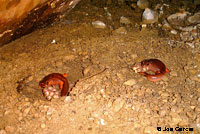 |
 |
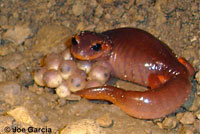 |
|||
| © Joe Garcia On August 3rd, Joe Garcia found these Ensatinas attending their eggs under a board underneath a house in Monterey County. Female Ensatinas stay with their eggs to protect them until they hatch. |
|||||
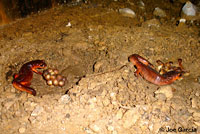 |
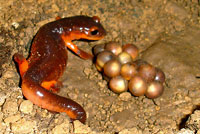 |
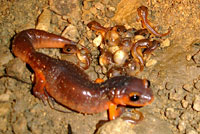 |
|||
| © Joe Garcia On September 19th, Joe returned to the crawl space, looked under the board, and found that most of the eggs of one female had just hatched, with at least 10 hatchlings still next to the eggs. |
|||||
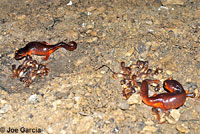 |
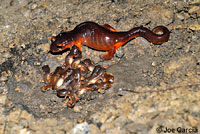 |
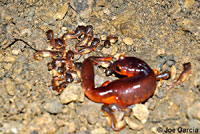 |
|||
| © Joe Garcia Two days later, all of the eggs of both females had hatched and the juveniles were still with the females. Juveniles probably remain where they hatched until the first rains of the season, which could be months. |
|||||
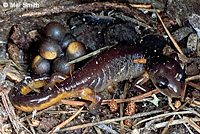 |
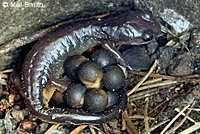 |
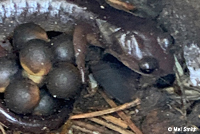 |
|||
| On August 25th. Linda Bostwick and Mel Smith discovered an adult Oregon Ensatina guarding her eggs inside a water meter box in Mendocino County. © Mel Smith | |||||
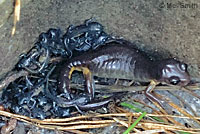 |
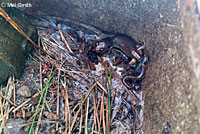 |
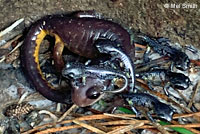 |
|||
| By September 10th the eggs had hatched and the mother and at least 11 hatchlings had not yet left the nest site. © Mel Smith | On October 10th 5 of the hatchlings and the mother were still present. © Mel Smith |
||||
| Observations on September 25th and October 1st showed that only 5 of the hatchlings were still present along with the mother. (The others may have climbed out or maybe they were victims of predation.) |
On October 27th a second adult was observed and 5 or more hatchlings were still present. |
||||
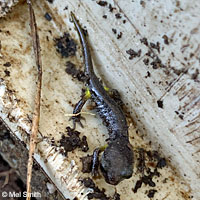 |
|||||
| On November 15th only three of the hatchlings were stil in the box. As is to be expected, most of the salamanders waited until the rains were well underway to leave. |
By November 20th, all of the hatchlings had apparently left the nest site in the water meter box. On November 23rd one hatchling had returned. |
||||
| Below is a series of pictures all © Spencer Riffle showing a female Wandering Salamander in Humboldt County brooding her eggs over a period of just over three months, when the eggs hatch and we can see the tiny hatchlings. Click Here to see a larger view. |
|||||
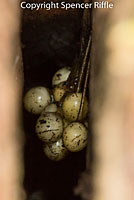 |
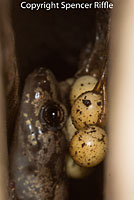 |
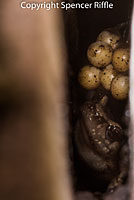 |
|||
| Female with eggs - 7/9 | Female with eggs - 7/10 | Female with eggs - 7/16 | |||
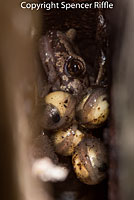 |
 |
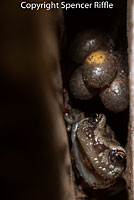 |
|||
| Female with eggs - 9/2 | Female with eggs - 9/2 | Female with eggs - 9/25 | |||
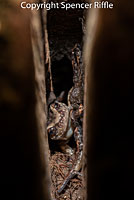 |
|||||
| Female with hatchlings - 10/14 | |||||
Return to the Top
© 2000 -

